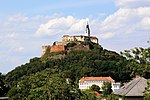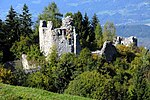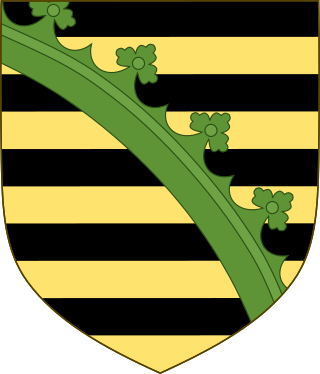
The House of Wettin was a dynasty of German kings, prince-electors, dukes, and counts that once ruled territories in the present-day German states of Saxony, Saxony-Anhalt and Thuringia. The dynasty is one of the oldest in Europe, and its origins can be traced back to the town of Wettin, Saxony-Anhalt. The Wettins gradually rose to power within the Holy Roman Empire. Members of the family became the rulers of several medieval states, starting with the Saxon Eastern March in 1030. Other states they gained were Meissen in 1089, Thuringia in 1263, and Saxony in 1423. These areas cover large parts of Central Germany as a cultural area of Germany.

Anton Florian was the Prince of Liechtenstein between 1718 and 1721.
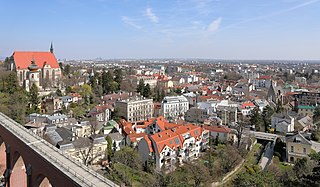
Mödling is the capital of the Austrian district of the same name located approximately 14 km south of Vienna.
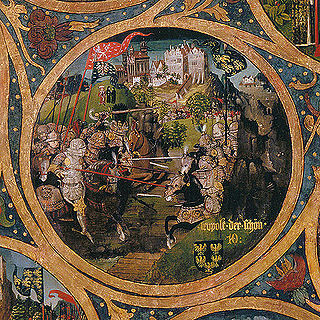
Leopold II, known as Leopold the Fair, a member of the House of Babenberg, was Margrave of Austria from 1075 until his death. A supporter of the Gregorian Reforms, he was one of the main opponents of the German king Henry IV during the Investiture Controversy.
Rohrau is a village in the state of Lower Austria. The name comes from two German words: Rohr (reed) and Au. South of the village is a riparian forest and a swamp covered with reed.

The House of Liechtenstein, from which the principality takes its name, is the family which reigns by hereditary right over the principality of Liechtenstein. Only dynastic members of the family are eligible to inherit the throne. The dynasty's membership, rights and responsibilities are defined by a law of the family, which is enforced by the reigning prince and may be altered by vote among the family's dynasts, but which may not be altered by the Government or Parliament of Liechtenstein.
Bezirk Bruck an der Leitha is a district of the state of Lower Austria in Austria.

The House of Harrach is the name of an old and influential Austro-German noble family, which was also part of the Bohemian nobility. The Grafen (Counts) of Harrach were among the most prominent families in the Habsburg Empire. As one of a small number of mediatized families, it belongs to the Uradel.

The ruins of Falkenstein Castle is in the Weinviertel region of Lower Austria, about 55 kilometres (34 mi) north of Vienna near the border to Czech Republic.

Petronell-Carnuntum is a community of Bruck an der Leitha in Austria. It is known for its annual World Theatre Festival.

Maria Enzersdorf is a small city in the district of Mödling in the Austrian state of Lower Austria.

Güssenburg Castle is a ruined castle on a hill near Hermaringen in Heidenheim County in Baden-Württemberg, Germany. It was built around 1346, during the High Middle Ages and much of the curtain wall and keep remain.

Julius Hans Weigel was an Austrian Jewish writer and a theater critic. He lived in Vienna, except during the period between 1938 and 1945, when he lived in exile in Switzerland. He was a lifetime companion of the Austrian actress Elfriede Ott.

The House of Abensberg und Traun is the name of an ancient Austrian noble family, originally from the Upper Austrian Traungau. It is considered one of the oldest extant aristocratic families in Central Europe.

Burg Kreuzenstein is a castle near Leobendorf in Lower Austria, Austria. Burg Kreuzenstein is 265 metres (869 ft) above sea level. It was constructed on the remains of a medieval castle that had fallen into disrepair and was then demolished during the Thirty Years' War. Intended to be a family vault for the Wilczek family, it was rebuilt in the 19th century by Count Nepomuk Wilczek with money from the family's large Silesian coal mines. Kreuzenstein is interesting in that it was constructed out of sections of medieval structures purchased by the family from all over Europe to form an authentic-looking castle. Thus, the castle can be considered both a 'neo-' and 'original' medieval structure. The castle is sometimes used as a location for films.

Burg Raabs an der Thaya is a castle in municipality Raabs an der Thaya, Lower Austria, Austria, built in the second half of the 11th century, it is 456 metres (1,496 ft) above sea level.

Anhalt Castle is a ruined medieval fortification near the town of Harzgerode in Saxony-Anhalt, Germany.
Lichtenstein Castle may refer to the following castles:

Schloss Rohrau is a castle in the town of Rohrau in Lower Austria, bordering on Burgenland. The building houses the art collection of the counts of Harrach.
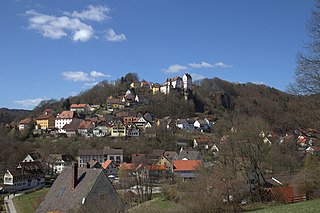
Egloffstein Castle is a former high mediaeval, aristocratic castle, that stands immediately west of the eponymous village of Egloffstein in the Upper Franconian county of Forchheim in the German state of Bavaria.





















